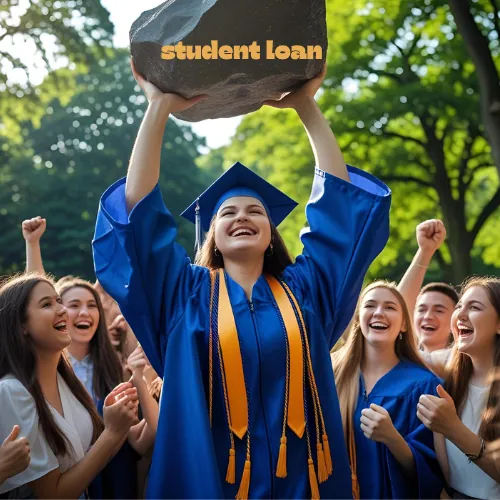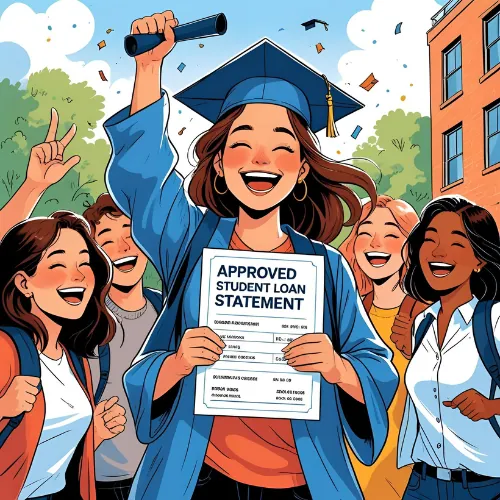Are you ready to take the next step in your educational journey but feeling anxious about how long it could take to get your student loan approved? Understanding the student loan approval time can help you plan better, meet school deadlines, and ease your financial worries. This guide is designed for students, parents, and anyone curious about the loan application process. We’ll dive deep into the timeline, highlight what influences the approval period, and offer practical advice to help you secure your funds as quickly as possible.
Are you preparing to embark on your college or university experience, or perhaps continuing your education journey, but feeling uncertain about how long it will take to secure the funds you need through a student loan? Understanding student loan approval time is crucial for prospective and current students, as well as their families, who rely on these financial resources to cover tuition, housing, textbooks, and other essential education-related expenses.
The period between submitting your student loan application and receiving a final decision can significantly affect your ability to pay for classes, register for courses on time, or even plan your move to campus. Whether you’re considering federal student loans, private student loans, or loans through banks and non-banking financial companies, the timeline to approval can vary widely based on factors like the completeness of your application, your lender’s internal processes, and even the seasonality of applications. Knowing what impacts student loan approval time, what steps are involved, and how you can proactively speed things along can make all the difference in stress levels and your educational planning.

Understanding Student Loan Approval Time
What Is Student Loan Approval Time?
Student loan approval time refers to the period from when you submit your loan application to when you receive a formal approval (or denial) decision from your lender. This timeline varies widely depending on the type of loan, the lender’s requirements, and how complete your application is. For most students, getting a clear idea about expected processing times and the steps involved makes planning and budgeting for tuition and living expenses much easier.
How Long Does It Take to Get a Student Loan Approved?
Typical Approval Timelines
- Federal Student Loans: Processing is generally quicker. After you submit the FAFSA, you’ll usually receive a response within 7–10 days. Additional requirements, like entrance counseling, could add a bit more time, but many students see funds disbursed within 2–3 weeks.
- Private Student Loans: Approval ranges from a few days to several weeks. Some lenders offer near-instant pre-qualification, while others require thorough credit and background checks that can take 2–6 weeks to complete. Cosigners or missing documents may extend this period.
- Banks, NBFCs, and Fintech: Large public banks typically take 1–3 weeks. Private lenders and fintech solutions are often quicker, promising approvals in as little as 5–10 working days for complete, well-documented applications.

| Lender Type | Usual Loan Approval Time |
|---|---|
| Federal Government | 7–10 days after FAFSA |
| Private Lender | 3 days – 6 weeks |
| Public Banks (India) | 1–3 weeks (longer for secured) |
| Private Banks (India) | 7–20 working days |
| Fintech/NBFC | 5–10 working days |
Factors Affecting Student Loan Approval Time
Why Does the Timeline Vary So Much?
Knowing what may slow down (or speed up) your application is vital.
1. Completeness of Your Application
Missing or incorrectly filled information almost always leads to delays. Double-check your paperwork before submission to avoid setbacks.
2. Type of Loan
Secured loans (those needing collateral) require extensive verification and can add days or weeks to your wait. Unsecured loans, including many fintech and NBFC options, are faster as long as credit checks pass.
3. Lender Policies and Approval Protocols
Every lender has distinct policies. For example, federal loans rely on FAFSA processing, while private institutions may require credit checks for both you and any cosigner. Lenders may also verify your school’s accreditation.
4. Creditworthiness and Co-signer Status
A strong credit profile (either yours or your co-signer’s) can fast-track approval. Weak credit or no co-signer can result in further scrutiny or outright denial, adding to the wait.
5. Document Verification and Additional Checks
Some institutions verify income, academic records, admission letters, and other documentation. Any missing pieces can stall your application, so responding quickly to requests for extra information is crucial.
6. Time of Year (Peak Periods)
Application spikes before academic terms can push approval times longer. Try to apply early—waiting for the deadline means facing larger backlogs.
7. School’s Financial Aid Office Procedures
For federal student loans, funds are disbursed through your school, often adding a few days after approval as tuition and fees get processed.
Step-by-Step Breakdown of the Student Loan Process
1. Application Submission (1–3 Days)
- Complete and submit your application online or at a lender’s office.
- Gather and organize all required documents.
2. Document Verification (3–7 Days)
- The lender reviews academic, financial, and identity documents.
- If a co-signer is needed, their paperwork must be verified as well.
3. Evaluation & Approval (5–10 Days)
- The lender examines your creditworthiness, chosen institution, and course.
- After satisfactory review, you’ll receive an approval letter.
4. Disbursement (1–4 Weeks after Approval)
- Funds are sent either to your school or your account, depending on the agreement.
- Some banks and fintech platforms are known for fast disbursement, especially for unsecured loans.

Practical Tips to Shorten Your Student Loan Approval Time
Actionable Advice for Faster Student Loan Approvals
1. Apply Early
Don’t wait for deadlines—apply as soon as you have an admission offer. Early birds avoid the rush and lower the risk of delayed tuition payments.
2. Double-Check Your Paperwork
Incomplete, inconsistent, or missing paperwork is the main source of delays. Use checklists provided by lenders, or contact loan officers for clarification.
3. Prepare a Strong Co-signer Profile (for Private Loans)
If your application needs a co-signer, make sure they have:
- Good credit
- Stable income
- Prompt paperwork readiness
A solid co-signer can both speed up approval and get you a better interest rate.
4. Respond Promptly to Lender Requests
Lenders often ask for clarifications or more documents. Set email alerts, and reply quickly to avoid unnecessary holdups.
5. Choose the Right Lender
Some private banks and NBFCs/fintech platforms offer “instant approval” education loans, especially for existing customers or those with strong financial backgrounds. Always compare processing times before choosing your lender.
6. Use School Financial Aid Office Resources
Most schools offer guidance and help in coordinating loan processes. Don’t hesitate to call or email your financial aid office for updates and advice.
Common Questions About Student Loan Approval Time
How long does federal student loan approval take?
Federal loans (like the FAFSA in the U.S.) usually take 7–10 days from application to initial offer. Disbursement aligns with your school’s payment deadlines.
Is it possible to get a student loan approved in under a week?
Yes, especially with fintech and private lenders, or if you are an existing bank customer with a history of timely repayments. Instant approvals are rare, but some platforms deliver decisions in 1–3 days for well-prepared applicants.
What if my application is delayed?
Delays can stem from missing documents, credit issues, or peak application seasons. Reach out to your lender or school to clarify holdups, and consider alternative sources (like university scholarships or payment plans) if you’re close to tuition due dates.
Can a denied loan application hurt my future chances?
Not necessarily, but multiple rejected applications in a short span can affect your credit score. If denied, try to address the reason (improving credit, more documentation, choosing another co-signer) before reapplying.
Examples: Realistic Student Loan Approval Scenarios
Scenario 1: Federal Loan Success
Jide fills out his FAFSA as soon as it’s available, double-checks his entries, and submits all documents. Within 7 days, he receives aid eligibility details and can plan tuition payments, stress-free.
Scenario 2: Private Bank Hurdles
Priya applies for a private student loan, but misses a required document. The bank emails her for clarification, which she spots 3 days later and replies. Her approval takes 4 weeks instead of the usual 2, highlighting the importance of prompt responses.
Scenario 3: Fast-Track with Fintech
Maya uses a fintech platform, uploading all documents after a checklist review. She gets provisional approval within 3 days and full disbursement by the next week—demonstrating the value of preparation.
Conclusion: Mastering the Student Loan Approval Process
The student loan approval time doesn’t have to be a mystery. By understanding lender timelines, preparing complete documents, choosing the right loan type, and staying proactive, you can minimize delays and secure your educational future. Remember, every day counts—apply early, stay organized, and keep lines of communication open with both your lender and your school’s financial aid.
Key Takeaways:
- Most education loans are approved within 1–3 weeks, but timelines can range from a few days to two months based on factors like completeness of documentation, lender type, and creditworthiness.
- Speed up the process by preparing documents, applying early, choosing a suitable co-signer, and staying in touch with your lender and school.
- Each delay has a specific fix—anticipate potential delays for a stress-free start to your academic journey